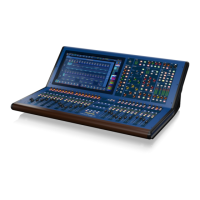106 HD96-24-CC-TP User Manual
Chapter 11. Soloing
With the Solo button you can isolate a single channel, which is helpful in fault nding or when equalising a signal. Pressing a Solo button cuts all signals routed to the
monitor output, except those channels where a Solo has been engaged. You can then monitor a signal at a level proportional to its level in the mix, in the same stereo
position in the mix and with the same reverberation as in the mix. It can also be used to listen to a group of channels assigned to a VCA, such as a drum kit which can
then be heard in full via a VCA. There are 2 monitor busses on HD96 – Solo A which interrupts Monitor A and Solo B which interrupts Monitor B. Both busses operate in
the same manner, so they have a similar set of controls for each. When a Solo is cleared, that monitor bus reverts to its previous monitoring selection.
Solo Button Functions
1. PFL Inputs A Pre-Fade Listen active for an input on solo bus A. If unlit, the solo will be AFL.
2. PFL Inputs B Pre-Fade Listen active for an input on solo bus B. If unlit, the solo will be AFL.
3. PFL Outputs A Pre-Fade Listen active for an output on solo bus A. If unlit, the solo will be AFL.
4. PFL Outputs B Pre-Fade Listen active for an output on solo bus B If unlit, the solo will be AFL.
5. ADD Solo Bus A Enables multiple solos to be heard at once. If unlit, only one solo at a time can be heard.
6. ADD Solo Bus B Enables multiple solos to be heard at once. If unlit, only one solo at a time can be heard.
7. CLEAR A Cancels all solos on A and returns Monitor A to its previous monitoring selection.
8. CLEAR B Cancels all solos on B and returns Monitor B to its previous monitoring selection.
The HD24 Control Surface has two independent solo systems, Solo A and Solo B. Solo A interrupts the Monitor A bus when a solo is activated; the Solo B interrupts the
Monitor B bus when a solo is activated. Any path can solo on either A or B. Both have monitor and headphone outputs, and both can be used to PFL or AFL signals from
the same sources throughout the control centre. This exible solo bus conguration makes soloing of monitor mixes incredibly easy— in-ears going to solo A and
wedge going to solo B — thus the ability to choose whether an input or output goes to solo A or solo B or on a channel by channel or Aux by Aux basis.
Note: The headphone level controls are independent of the Solo A and B bus level. This means if you use the C/O button for a Monitor Bus and use the fader to control
a local monitor speaker or a PFL IEM system, the headphones will still be audible (if the level is turned up) even if this fader is all the way down.

